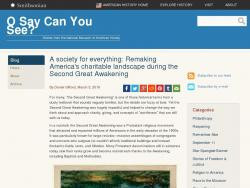Kate Harris
Social Studies teacher
Pittsburgh CAPA
Middle School (13 to 15 years old), High School (16 to 18 years old)
Teacher/Educator
Language Arts And English, Civics, Literature, Cultures, Economics, Social Studies, Geography, Writing, US History, Arts, Other
I'm a history-lover, art fan, and bookworm. I taught high school history (U.S. History and World Religions) for ten years in North Carolina, teach currently in Pittsburgh, PA, and am working to help teachers make the most of this new resource!
Kate Harris's collections
The Steamboat Arabia
<p style="margin-left:32px;">This collection was made to pair with a learning experience during the November 17th workshop for Pittsburgh teachers working with the Smithsonian Learning Lab. Teachers will visit the Steamboat Arabia exhibit and learn from a Heinz History Center curator about the decisions made and limitations faced when creating an exhibit for visitors to learn from. </p><p style="margin-left:32px;">Both the online collection and the Heinz History Center exhibit explore the question "<strong>How do new innovations in transportation affect American life?"</strong></p><p style="margin-left:32px;">The collection below contains artifacts and images from the Smithsonian collection that might help students and teachers respond to the question above. Suggested scaffolding questions might include:</p><ul><li>Identify the changes in technology and transportation that occurred between 1800-1850.</li><li>How did these new transportation systems impact the movement and interactions of groups of people, the expansion of trade, and cultural life on the frontier?</li><li>How do the items in this collection compare to what was found during the recovery of the Steamboat Arabia?</li></ul>
 Kate Harris
Kate Harris
22
Why did the Second Great Awakening inspire reform movements?
<p>The Second Great Awakening was a religious revival movement in the first half of the 19th century. It emphasized emotion and enthusiasm, but also democracy: new religious denominations emerged that restructured churches to allow for more people involved in leadership, an emphasis on man's equality before god, and personal relationships with Christ (meaning less authority on the part of a minister or priest). There was also a belief that the Second Coming was imminent, and society must be improved before that time. Women were heavily involved in the 2nd Great Awakening movement, converting in large movements and taking on leadership roles in service committees and reform work. </p><p>Students and teachers might use this collection as a topical resource to explore:<strong> Why and how did the Second Great Awakening inspired a range of antebellum reform movements?</strong></p><p>Other questions that might support this inquiry include:</p><ul><li>How are concepts of democracy and equality important to both the Second Great Awakening and the rise of reform movements?</li><li>Why do you think women were often leaders in antebellum reform movements?</li><li>More Americans were moving westward during this period. How do you think that impacted the religious revival movement?</li><li>Can you hypothesize a connection between the increase in utopian societies during this time and the growing reform and religious movements?</li></ul><p>Tags: abolition, temperance, women's rights, women's suffrage, second coming, antebellum reform, asylum and prison reform, education, 2GA</p>
 Kate Harris
Kate Harris
35
History of Mormons in America
<p>This collection of artifacts, photographs, texts, and historical markers is intended to help students explore the history of the Mormon religion in America. </p><p>Each of these items is intended to spark inquiry, following the process below: </p><ol><li>Students should choose one artifact on which to focus. </li><li>Have them use the artifact analysis PDF (last resource) to begin their study of the artifact. </li><li>Next, have students generate questions about the artifact? What do they wonder about? What does it tell them about the Mormon religion or its history within the United States? </li><li>Have students complete some general research on their artifact that will help their classmates piece together the story of the Mormon experience.</li></ol><p>As a collaborative project, students should use the PBS Forced Migrations map/timeline as a model for a class map/timeline of their own. </p><ol><li>Project an image of the map on a class whiteboard or create your own basic outline using large paper. </li><li>Have each student present their research findings. The main questions they should answer are: What does it represent about the Mormon experience? Where would the artifact they chose be placed (geographically and in terms of chronology)? </li><li>Students should then place place their image on the map with significant dates noted. </li><li>After all groups have presented, review the narrative of the Mormon experience with the class. What would they identify as critical moments in Mormon history? What questions do they still have?</li></ol><div>Tags: religion, Moroni, Joseph Smith, Brigham Young, Mormon, New York, Utah, Illinois, gold plates, inquiry</div>
 Kate Harris
Kate Harris
18
Globalization and Cultural Diffusion
<p>This student activity focuses on the concepts of globalization and cultural diffusion. Students will look at a variety of artifacts and explain how they illustrate the two concepts and/or help answer the guiding questions below:</p><ul><li>What is globalization and how does it affect people and places?</li><li>What leads to cultural diffusion?</li></ul>
 Kate Harris
Kate Harris
10
The Melting Pot at the United Shoe Machinery Corporation
<p>This student activity includes a set of archival documents from the United Shoe Machinery Corporation. These documents can be used as resources to help students investigate the relationship between industry, education, and immigration in the early 20th century. </p><p>As students explore the collection, they should consider how each document helps them answer the following questions:</p><p>-Is it in the best interests of business to encourage citizenship and education? Why or why not?</p><p>-What do these materials say about what it means to be considered "American" in the early 20th century?</p><p>tags: school, learning, English, language, migration, Ellis Island, manufacturing, Progressives</p>
 Kate Harris
Kate Harris
8
What stories do artifacts tell?
<p>This student activity asks students to develop a story about a mystery artifact, editing and adjusting their narrative as they discover more information. Students will develop historical thinking skills while learning more about the experience of living in a specific time and place.</p>
<p>tags: Japan, internment, incarceration, Manzanar, World War II, World War 2, WW2, Executive Order 9066, Roosevelt, FDR</p>
<p><em>#historicalthinking</em></p><p><br /></p>
 Kate Harris
Kate Harris
12
Attention-grabbing headlines don't always tell truth!
<p><strong>Attention-grabbing headlines don't always tell truth!</strong></p><p><strong>Pictures are powerful, sometimes edited!</strong></p><p><strong>Twitter doesn't tell whole story.</strong></p><p><br /></p><p>In the era of "fake news" and information overload, we all need to become better readers of the words and pictures that are used to explain what is going on in the world around us. In this activity, students and teachers will consider:</p><p><strong>How<span></span></strong><strong> can the choice of image or words convey different messages about current events? How do journalists and editors shape the news through their choices?</strong><br /></p><p>This student activity asks students to look at several images of young people resisting a law or recent event. Their task is to write two different headlines for that image designed to appeal to different audiences. They will also be asked to research the context for the image and to consider how that might impact their headlines. </p><p>The goals of this lesson are to:</p><ul><li>explore image and word choice as news drivers (factors that make items newsworthy or appealing to readers)</li><li>determine how journalists and editors shape the news through their choices</li><li>encourage news literacy and a critical reading of headlines and photojournalism in the future. </li></ul>
 Kate Harris
Kate Harris
15
The Ramayana
<p>This teaching collection and student activity includes the resources necessary to teach an EDSITEment lesson on the Ramayana where students read closely to find examples of the Hindu concept of dharma. </p><p>Guiding questions are:</p><ul><li>What is <em>dharma</em>?</li><li>How does the <em>Ramayana</em> teach <em>dharma</em>, one of Hinduism's most important tenants?</li></ul><p>tags: Hinduism, Hindu, India, dharma, Ramayana, rama, epic, Vishnu</p>
 Kate Harris
Kate Harris
11
Look for the Helpers: Analyzing Social Movements
<p>Mr. Rogers is quoted as saying, “When I was a boy and I would see scary things in the news, my mother would say to me, "Look for the helpers. You will always find people who are helping." This collection will give students a framework to "look for the helpers"--the people who are trying to change society for the better during difficult times. Students will be introduced to a variety of strategies and tactics used in social movements, and consider how these might apply to an area of their own interest.</p><p>Included is a chart listing possible strategies for social movements that encourages students to find examples of tactics/strategies from the collection and determine the goals of each.</p><p>Opportunities for extension include:</p><p>Identify a social movement that relies on more than one strategy (most do). Can you create a "recipe" listing the various tactics used to create a successful movement?</p><p>Who is involved? Choose one of the examples from above to study further. Who was involved in that particular tactic or strategy? Consider different occupations (teacher, writer, church leader, student, mother) and also different demographics (gender, race, age, ethnicity, etc.)</p><p>What's missing? Are there strategies that you have encountered in your research that don't fit into this chart?</p>
 Kate Harris
Kate Harris
31
Who is Frances Mary Albrier?
<p>This is a collection of items belonging to, or about, Frances M. Albrier. Although an important female leader and activist during the mid-20th century, many students may not have heard of Ms. Albrier. Encourage students to act as history detectives, exploring the collection to determine why this woman's belongings are in the collections of the Smithsonian.</p>
<p>Some questions to consider:</p>
<ul><li>What are Albrier's main accomplishments? What types of occupations did she have?</li><li> Based on these, what values do you think were important to her?</li><li>How does Albrier's life reflect major changes for women during the 20th century? Changes for African-Americans?</li><li>What do these items tell us about challenges facing African-American women in the mid-century?</li><li>What remains unknown about Albrier based on this collection? Where else could you go to look for more information?</li><li>Look at an encyclopedia entry for Ms. Albrier. Are there any events mentioned not covered in this collection? What might be a good item to add in order to better show her life?</li></ul><p><br /></p>
<p>tags: activism, civil rights, union, labor, voter registration, 60s, world war II, shipyards, WW2, nursing, Red Cross, National Council of Negro Women, Nigeria, independence, peace, moral rearmament, #BecauseOfHerStory</p>
 Kate Harris
Kate Harris
15
The Concept of God in Hinduism
<p>This topical collection is meant to serve as a starting point to explore the concept of god in Hinduism. Students can review the images in the collection for clues to help them answer questions like:</p><p>-How are gods portrayed in relation to other gods, people, or animals?</p><p>-Do there seem to be one god or many gods? Do they seem to be male or female? </p><p>-What common symbols or poses are present? What do you think they mean? </p><p>-What kinds of powers do the god figures seem to have? In what ways are they like human beings and in what ways are they different? </p><p>The final resource in this collection is a video that gives insight into the Hindu concept of god. After exploring this collection, encourage students to choose one aspect of Hinduism that they would like to research further.</p><p>tags: India, religion, Brahma, Vishnu, Shiva, trimurti, Ganesh, avatar</p>
 Kate Harris
Kate Harris
18
The 1950s--A Decade Collection
<p>This is a topical collection about American life and politics in the 1950s. Resources in this collection might be helpful to students and teachers working on projects about the decade. It is not meant to be completely comprehensive, but rather includes highlights of the Smithsonian's collection spanning art, popular culture, social trends, leadership, and technology. </p><p>Teachers and students might copy and adapt this collection to suit their needs; highlighting a specific aspect of life in the 1950s and adding annotations and additional resources. </p>
 Kate Harris
Kate Harris
80





